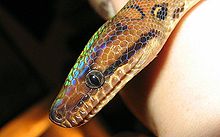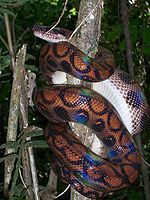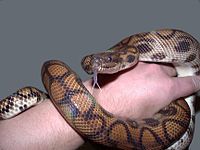- Epicrates cenchria
-
Epicrates cenchria 
Scientific classification Kingdom: Animalia Phylum: Chordata Subphylum: Vertebrata Class: Reptilia Order: Squamata Suborder: Serpentes Family: Boidae Subfamily: Boinae Genus: Epicrates Species: E. cenchria Binomial name Epicrates cenchria
(Linnaeus, 1758)Synonyms - Boa cenchria - Linnaeus, 1754
- [Boa] Cenchria - Linnaeus, 1758
- Coluber tamachia - Scopoli, 1788
- Boa Cenchris - Gmelin, 1788
- Boa aboma - Daudin, 1803
- Boa ternatea - Daudin, 1803
- Boa annulifer - Daudin, 1803
- [Epicrates] cenchria - Wagler, 1830
- Cliftia fusca - Gray, 1849
- Epicarsius cupreus - Fischer, 1856
- Epicarsius cupreus - Brown, 1893
- Epicrates cenchris - Boulenger, 1893
- Epicrates cenchria - Griffin, 1916
- Epicrates cenchria var. fusca - Griffin, 1916
- Epicrates cenchria cenchria - Amaral, 1930
- Epicrates cenchria cenchria - Stull, 1938[1]
Epicrates cenchria is a boa species found in Central and South America. Common names include the rainbow boa,[2] and slender boa. A terrestrial species, it is known for its attractive iridescent sheen. Nine subspecies are currently recognized, including the nominate subspecies described here.[2]
Contents
Geographic range
Found in lower Central America in Costa Rica and Panama. In South America it occurs east of the Andes in Colombia, Venezuela, Trinidad and Tobago, Guyana, Suriname, French Guiana, Brazil, Ecuador, Peru, Bolivia, Paraguay and northern Argentina (in the provinces of Chaco, Córdoba, Corrientes, Formosa, Salta, Santiago del Estero and Tucumán). The type locality given is "Surinami."[1]
Captivity
Despite requiring very specific humidity and heat this species is commonly found in the pet trade. During the 1980s and early 1990s, substantial numbers were exported from Suriname. Today, however, far fewer are exported and most offered for sale are captive bred.[3] Due to their requirements of high humidity in a captive environment they should be considered of intermediate difficulty for snake owners, but once these requirements have been met they generally thrive in captivity. Younger specimens will often bite, but tend to calm down as they become more used to handling.
Subspecies
Subspecies[2] Taxon author[2] Common name Geographic range E. c. alvarezi Abalos, Baez & Nader, 1964 Argentine rainbow boa E. c. assisi Machado, 1945 Caatinga rainbow boa E. c. barbouri Stull, 1938 Marajo Island rainbow boa E. c. cenchria (Linnaeus, 1758) Brazilian rainbow boa E. c. crassus (Cope, 1862) Paraguayan rainbow boa E. c. gaigei Stull, 1938 Peruvian rainbow boa E. c. hygrophilus Amaral, 1935 Espirito Santo rainbow boa E. c. maurus Gray, 1849 Colombian rainbow boa E. c. polylepis Amaral, 1935 Central highland rainbow boa Gallery
- Images gallery
See also
- List of boine species and subspecies
- Boinae by common name
- Boinae by taxonomic synonyms
References
- ^ a b McDiarmid RW, Campbell JA, Touré T. 1999. Snake Species of the World: A Taxonomic and Geographic Reference, vol. 1. Herpetologists' League. 511 pp. ISBN 1-893777-00-6 (series). ISBN 1-893777-01-4 (volume).
- ^ a b c d "Epicrates cenchria". Integrated Taxonomic Information System. http://www.itis.gov/servlet/SingleRpt/SingleRpt?search_topic=TSN&search_value=209561. Retrieved 10 July 2008.
- ^ Brazilian Rainbow Boa at Smithsonian National Zoological Park. Accessed 12 November 2008.
External links
- Epicrates cenchria at the Reptarium.cz Reptile Database. Accessed 10 July 2008.
Categories:- Boinae
- Fauna of Guyana
Wikimedia Foundation. 2010.


